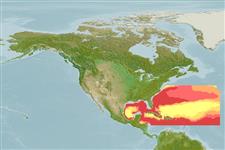Elasmobranchii (sharks and rays) >
Squaliformes (Sleeper and dogfish sharks) >
Etmopteridae (Lantern sharks)
Etymology: Etmopterus: Greek, ethmos, -ou = sieve or ethmoides bone + Greek, pteron = wing, fin (Ref. 45335).
Eponymy: Richard Hill (1795–1872) was a Jamaican anti-slavery activist, judge, botanist and naturalist who was in England (1827–1830) and was closely involved with men like Wilberforce and other prominent members of the Anti-Slavery Society. [...] (Ref. 128868), visit book page.
More on author: Poey.
Environment: milieu / climate zone / depth range / distribution range
Ecology
Marine; pelagic-oceanic; depth range 180 - 717 m (Ref. 51158). Deep-water; 39°N - 15°N
Western Atlantic: Virginia to southern Florida (USA), Cuba, Bermuda, and St. Kitts (Ref. 247); including Brazil (Ref. 53443). Eastern Atlantic (Ref. 26340).
Length at first maturity / Size / Weight / Age
Maturity: Lm ?, range 30 - ? cm
Max length : 29.5 cm TL male/unsexed; (Ref. 106604)
Inhabits the upper continental and insular slopes. Found on sandy bottoms (Ref. 26340). Ovoviviparous with 4 to 5 young in a litter. Maximum size reported in Ref. 106604 after Bigelow & Schroeder (1948). Maximum sizes of 31.5 cm precaudal length (Longley & Hildebrand,
1941) and 50.0 cm TL (Ref. 247) probably refer to the subsequently described and very similar E. robinsi, which attains a greater maximum size according to Schofield & Burgess (1997) (Ref. 106604).
Ovoviviparous with 4 to 5 young in a litter. Size at birth about 9 cm (Ref. 247). Distinct pairing with embrace (Ref. 205).
Compagno, L.J.V., 1984. FAO Species Catalogue. Vol. 4. Sharks of the world. An annotated and illustrated catalogue of shark species known to date. Part 1 - Hexanchiformes to Lamniformes. FAO Fish. Synop. 125(4/1):1-249. Rome, FAO. (Ref. 247)
IUCN Red List Status (Ref. 130435: Version 2024-2)
Threat to humans
Harmless
Human uses
Fisheries: subsistence fisheries
Tools
Special reports
Download XML
Internet sources
Estimates based on models
Preferred temperature (Ref.
123201): 10.3 - 18.6, mean 14.2 °C (based on 60 cells).
Phylogenetic diversity index (Ref.
82804): PD
50 = 0.5000 [Uniqueness, from 0.5 = low to 2.0 = high].
Bayesian length-weight: a=0.00380 (0.00194 - 0.00745), b=3.09 (2.92 - 3.26), in cm total length, based on LWR estimates for this Genus-body shape (Ref.
93245).
Trophic level (Ref.
69278): 4.5 ±0.80 se; based on food items.
Resilience (Ref.
120179): Very Low, minimum population doubling time more than 14 years (Fec=4).
Fishing Vulnerability (Ref.
59153): Low vulnerability (20 of 100).
